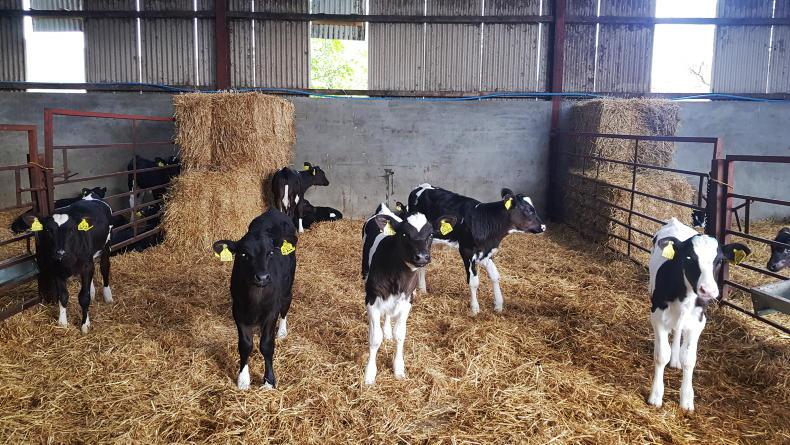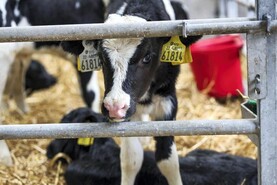Animal health issues can have a major impact on the economic, health and environmental sustainability of your dairy business.
Farmers in the Dairylink programme have addressed these issues through the successful development and implementation of an animal health plan, in conjunction with their local vet.
However, it is important to review the plan each year. That process was recently completed by John Oliver, along with his vet, Keith Laughlin from Riada Veterinary Clinic.
Why have a plan?
Animal health planning allows you to improve the health status of your herd, which will make you more money. For example, figures from the Agriculture and Horticulture Development Board (AHDB) indicate that the average cost associated with a case of lameness is around £320.

After the latest animal health review, John is to alter his vaccination programme for calves.
Implementing the steps recommended on John’s plan meant that there were only 14 cases of lameness recorded on the farm last year, thus helping to reduce production costs.
Improving the health status will also enhance cow longevity, which has a positive environmental benefit. In addition, animal health planning should help to reduce reliance on the need for antibiotic treatments, therefore minimising the risk of developing antibiotic-resistant infections that could potentially transfer to the human population.
Producing a plan
Animal health plans are required by dairy farmers to achieve accreditation in various certification schemes. However, Dairylink farmers have recognised the additional benefits of animal health planning and developed a working document with their local vet.
When drawing up the initial plan, the advice is to identify the three main areas for the business to focus on. This is done by carrying out a review of the farm facilities, working practices and all health issues recorded on the farm during the previous 12 months.
Spending time on this exercise allowed me get a better appreciation of the cows, how they were being managed, and identify the main issues to focus on
Each farm needed to prepare its own plan, as issues varied between the units. The process takes a bit of time (up to two hours), but it should not be rushed, and ultimately it is time well spent.
“Spending time on this exercise allowed me get a better appreciation of the cows, how they were being managed, and identify the main issues to focus on,” says Keith.
From John’s perspective, having that fresh insight from someone outside the farm is important, and forced him to consider a different approach to animal health.
Among the actions flowing from his animal health plan was the development of a set of standard operating procedures (SOP) to address a range of issues. The solutions were often easy to implement and produced quick results.
For example, when John adopted the SOP for reducing mastitis on his farm, he recorded a 15-fold reduction in mastitis cases over a 12-month period and a reduction in somatic cell count from over 300,000 cells/ml to around 150,000 cells/ml.
A set of SOP around milking routines was developed and pulsation ratios were adjusted
Elements of the plan included the identification and culling of persistent offenders and taking milk culture samples, the results of which led Keith to conclude that milking procedures needed to be reviewed.
A set of SOP around milking routines was developed and pulsation ratios were adjusted. Adopting these measures was found to have a rapid positive impact.
Other benefits
For the project farmers, the calendar of events is a useful item within the health plan.
“The calendar just serves as a clear reminder of when all animals on the farm need to be treated or vaccinated, so I remember when to order the necessary materials,” says John.
But ultimately, the key is to remember that a plan is a working document. Circumstances can change on your farm, so it is necessary to review the plan on an annual basis to allow you to get the most from it.
A review of the farm roadways identified some sections that were uneven and muddy and could be contributing to the problem
During the latest review between John and Keith, they noted that while incidences of lameness and mastitis had improved, other issues had appeared which needed to be addressed.
For example, lameness cases involving white line disease and digital dermatitis have almost been eliminated on the farm, but there were increasing numbers of cows with bruising and sole ulcers.
A review of the farm roadways identified some sections that were uneven and muddy and could be contributing to the problem. John is to fix these areas before turnout next season.
In addition, John is planning to alter the vaccination programme for calves so that they are covered for a greater range of pneumonia-causing organisms.
He will also target-sample a number of cows for Johne’s disease later this winter and intends on keeping a more detailed account of health events on a whiteboard so that he can identify potential issues quicker.
Develop an animal health plan for your farm.Discuss the health issues that affect your business with your vet.Focus on two to three key issues initially.Review the plan on an annual basis. Read more
Ready for winter feeding in Co Antrim
Get replacements off to a good start
Animal health issues can have a major impact on the economic, health and environmental sustainability of your dairy business.
Farmers in the Dairylink programme have addressed these issues through the successful development and implementation of an animal health plan, in conjunction with their local vet.
However, it is important to review the plan each year. That process was recently completed by John Oliver, along with his vet, Keith Laughlin from Riada Veterinary Clinic.
Why have a plan?
Animal health planning allows you to improve the health status of your herd, which will make you more money. For example, figures from the Agriculture and Horticulture Development Board (AHDB) indicate that the average cost associated with a case of lameness is around £320.

After the latest animal health review, John is to alter his vaccination programme for calves.
Implementing the steps recommended on John’s plan meant that there were only 14 cases of lameness recorded on the farm last year, thus helping to reduce production costs.
Improving the health status will also enhance cow longevity, which has a positive environmental benefit. In addition, animal health planning should help to reduce reliance on the need for antibiotic treatments, therefore minimising the risk of developing antibiotic-resistant infections that could potentially transfer to the human population.
Producing a plan
Animal health plans are required by dairy farmers to achieve accreditation in various certification schemes. However, Dairylink farmers have recognised the additional benefits of animal health planning and developed a working document with their local vet.
When drawing up the initial plan, the advice is to identify the three main areas for the business to focus on. This is done by carrying out a review of the farm facilities, working practices and all health issues recorded on the farm during the previous 12 months.
Spending time on this exercise allowed me get a better appreciation of the cows, how they were being managed, and identify the main issues to focus on
Each farm needed to prepare its own plan, as issues varied between the units. The process takes a bit of time (up to two hours), but it should not be rushed, and ultimately it is time well spent.
“Spending time on this exercise allowed me get a better appreciation of the cows, how they were being managed, and identify the main issues to focus on,” says Keith.
From John’s perspective, having that fresh insight from someone outside the farm is important, and forced him to consider a different approach to animal health.
Among the actions flowing from his animal health plan was the development of a set of standard operating procedures (SOP) to address a range of issues. The solutions were often easy to implement and produced quick results.
For example, when John adopted the SOP for reducing mastitis on his farm, he recorded a 15-fold reduction in mastitis cases over a 12-month period and a reduction in somatic cell count from over 300,000 cells/ml to around 150,000 cells/ml.
A set of SOP around milking routines was developed and pulsation ratios were adjusted
Elements of the plan included the identification and culling of persistent offenders and taking milk culture samples, the results of which led Keith to conclude that milking procedures needed to be reviewed.
A set of SOP around milking routines was developed and pulsation ratios were adjusted. Adopting these measures was found to have a rapid positive impact.
Other benefits
For the project farmers, the calendar of events is a useful item within the health plan.
“The calendar just serves as a clear reminder of when all animals on the farm need to be treated or vaccinated, so I remember when to order the necessary materials,” says John.
But ultimately, the key is to remember that a plan is a working document. Circumstances can change on your farm, so it is necessary to review the plan on an annual basis to allow you to get the most from it.
A review of the farm roadways identified some sections that were uneven and muddy and could be contributing to the problem
During the latest review between John and Keith, they noted that while incidences of lameness and mastitis had improved, other issues had appeared which needed to be addressed.
For example, lameness cases involving white line disease and digital dermatitis have almost been eliminated on the farm, but there were increasing numbers of cows with bruising and sole ulcers.
A review of the farm roadways identified some sections that were uneven and muddy and could be contributing to the problem. John is to fix these areas before turnout next season.
In addition, John is planning to alter the vaccination programme for calves so that they are covered for a greater range of pneumonia-causing organisms.
He will also target-sample a number of cows for Johne’s disease later this winter and intends on keeping a more detailed account of health events on a whiteboard so that he can identify potential issues quicker.
Develop an animal health plan for your farm.Discuss the health issues that affect your business with your vet.Focus on two to three key issues initially.Review the plan on an annual basis. Read more
Ready for winter feeding in Co Antrim
Get replacements off to a good start







 This is a subscriber-only article
This is a subscriber-only article










SHARING OPTIONS: